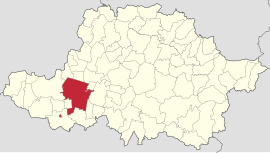
Back Arad ACE Arad AN أراد Arabic أراد ARY اراد ARZ Arad (şəhər) Azerbaijani آراد (رومانی) AZB Arads BAT-SMG Арад (Румынія) Byelorussian Арад BE-X-OLD
Arad | |
|---|---|
|
| |
 Location in Arad County | |
| Coordinates: 46°10′30″N 21°18′45″E / 46.17500°N 21.31250°E | |
| Country | Romania |
| County | Arad |
| Government | |
| • Mayor (2020–2024) | Călin Bibarț[1] (PNL) |
| Area | 46.18 km2 (17.83 sq mi) |
| Elevation | 117 m (384 ft) |
| Population (2021-12-01)[2] | 145,078 |
| • Density | 3,100/km2 (8,100/sq mi) |
| Time zone | EET/EEST (UTC+2/+3) |
| Postal code | 31xxx |
| Area code | (+40) 02 57 |
| Vehicle reg. | AR |
| Website | www |
Arad (Romanian pronunciation: [aˈrad] ) is the capital city of Arad County, at the edge of Crișana and the Banat. No villages are administred by the city. It is the third largest city in Western Romania, behind Timișoara and Oradea, and the 12th largest in Romania, with a population of 145,078.
A busy transportation hub on the Mureș River and an important cultural and industrial center, Arad has hosted one of the first music conservatories in Europe,[3][4] one of the earliest normal schools in Europe,[5] and the first car factory in Hungary and present-day Romania.[6] Today, it is the seat of a Romanian Orthodox archbishop and features a Romanian Orthodox theological seminary and two universities.
The city's multicultural heritage is owed to the fact that it has been part of the Kingdom of Hungary, the Eastern Hungarian Kingdom, the Ottoman Temeşvar Eyalet, Principality of Transylvania, Austro-Hungarian Empire, and since 1920 Romania, having had significant populations of Hungarians, Germans, Jews, Serbs, Bulgarians[7] and Czechs[8] at various points in its history. During the second half of the 19th century and the beginning on the 20th century, the city experienced rapid development. The most impressive displays of architecture that are still the popular sights of Arad today, such as the neoclassical Ioan Slavici Theater, the eclectic Administrative Palace and the neogothic Red Church, were built in this period.
- ^ "Results of the 2020 local elections". Central Electoral Bureau. Retrieved 8 June 2021.
- ^ "Populaţia rezidentă după grupa de vârstă, pe județe și municipii, orașe, comune, la 1 decembrie 2021" (XLS). National Institute of Statistics.
- ^ Dorin Frandeș, Spații arădene care au găzduit muzică – Pitești : Nomina 2011 ISBN 978-606-535-327-5;
- ^ www.sysadmins.ro, SysAdmins :: 2015. "Consiliul Judetean Arad". www.cjarad.ro. Retrieved 11 June 2017.
{{cite web}}: CS1 maint: numeric names: authors list (link) - ^ "Preparandia Română". AradCityGuide (in Romanian). Retrieved 2019-01-30.
- ^ "Prima fabrică de automobile din ţară a fost construită la Arad". adevarul.ro. 31 March 2011. Retrieved 2019-01-30.
- ^ Marco, Gabriela Adina. "Realități demografice de pe Valea Mureșului Inferior în a doua jumătate a secolului al XIX-lea și la începutul secolului al XX-lea" (PDF). Retrieved 23 February 2019.
- ^ "Volumul II: Populația stabilă (rezidentă) – structura etnică și confesională". Recensământul populației și al locuințelor 2011. INSSE. Archived from the original on 26 September 2021. Retrieved 23 February 2019.










